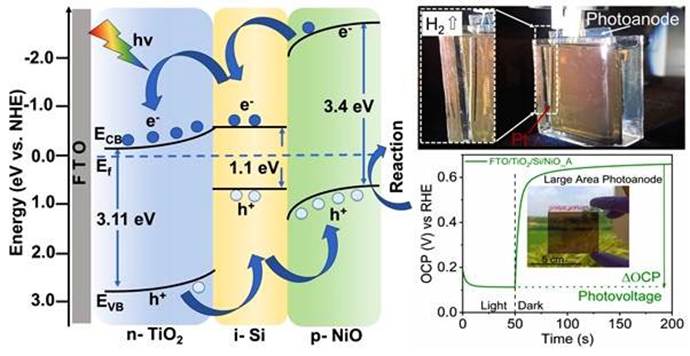Content:
- India’s solar leap to produce Green Hydrogen by splitting water molecules using only solar energy
India’s solar leap to produce Green Hydrogen by splitting water molecules using only solar energy
Scientific Breakthrough
- Scientists at Centre for Nano and Soft Matter Sciences (CeNS), Bengaluru, under DST, developed a next-generation solar device.
- The device produces green hydrogen by splitting water molecules using only solar energy, without fossil fuels or expensive rare materials.
Relevance : GS 3(Science and Technology)

What is Green Hydrogen?
- Cleanest fuel capable of:
- Decarbonizing heavy industries
- Powering zero-emission vehicles
- Storing renewable energy effectively
- India aims to become a global leader in Green Hydrogen Mission under its clean energy transition.
Technology Highlights
- Built using n-i-p heterojunction (n-type TiO₂, intrinsic Si, p-type NiO).
- Silicon-based photoanode boosts:
- Light absorption
- Charge separation and transport
- Minimizes recombination losses
- Fabrication via magnetron sputtering, an industry-ready, scalable technique.
Performance & Efficiency
- Achieved:
- 600 mV surface photovoltage (SPV)
- Low onset potential of ~0.11 V_RHE
- Over 10 hours continuous operation with only 4% degradation in alkaline conditions.
- Demonstrated at large-scale (25 cm² photoanode) — proving real-world viability.
Significance
- Combines efficiency, scalability, and affordability — rare in current green hydrogen tech.
- Enables direct solar-to-hydrogen conversion with earth-abundant, non-toxic materials.
- Supports India’s goal of achieving energy self-reliance and net-zero emissions by 2070.
Research Impact & Future Scope
- Published in Journal of Materials Chemistry A (Royal Society of Chemistry).
- Encourages future development of solar-hydrogen systems for homes, factories, and mobility.
- Sets a global benchmark in clean hydrogen innovation.
Photoelectrochemical (PEC) Water Splitting – CeNS Device (2025)
Pros:
- One-step, clean conversion – no need for external electricity.
- Scalable using abundant materials (Si, TiO₂, NiO).
- Low operating voltage (0.11 VRHE) → efficient.
- Demonstrated long-term stability (10+ hrs, only 4% drop).
Cons:
- Still in R&D stage – not yet widely commercialized.
- Efficiency lower than best electrolysis methods (as of now).
- Sensitive to material degradation over time and conditions.
Comparison Table
| Method | Pros | Cons |
| Electrolysis (RE-based) | Mature, modular, high purity | High cost, two-system dependency |
| Biomass Gasification | Waste utilization, multi-output | Partial emissions, supply chain issues |
| Photobiological | Natural, ambient | Very low efficiency, not scalable |
| Solar Thermal Splitting | No electricity, high theoretical yield | Complex, high-temp tech |
| PEC (CeNS 2025) | Single-step, efficient, scalable | Research stage, stability concerns |



